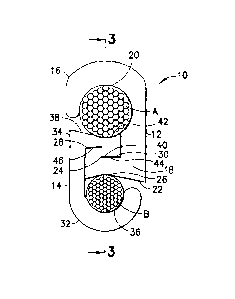Some of the information on this Web page has been provided by external sources. The Government of Canada is not responsible for the accuracy, reliability or currency of the information supplied by external sources. Users wishing to rely upon this information should consult directly with the source of the information. Content provided by external sources is not subject to official languages, privacy and accessibility requirements.
Any discrepancies in the text and image of the Claims and Abstract are due to differing posting times. Text of the Claims and Abstract are posted:
| (12) Patent: | (11) CA 2676943 |
|---|---|
| (54) English Title: | ELECTRICAL CONNECTOR |
| (54) French Title: | CONNECTEUR ELECTRIQUE |
| Status: | Granted and Issued |
| (51) International Patent Classification (IPC): |
|
|---|---|
| (72) Inventors : |
|
| (73) Owners : |
|
| (71) Applicants : |
|
| (74) Agent: | BCF LLP |
| (74) Associate agent: | |
| (45) Issued: | 2016-08-02 |
| (22) Filed Date: | 2009-08-28 |
| (41) Open to Public Inspection: | 2010-03-12 |
| Examination requested: | 2014-08-04 |
| Availability of licence: | N/A |
| Dedicated to the Public: | N/A |
| (25) Language of filing: | English |
| Patent Cooperation Treaty (PCT): | No |
|---|
| (30) Application Priority Data: | ||||||
|---|---|---|---|---|---|---|
|
An electrical connector element including a first section
and a second section. The first section has a general hook
shape with a first conductor contact surface on an inward
facing surface of the general hook shape. The second section
is integrally formed with the first section. The second
section has a first side forming a second conductor contact
surface and an opposite second side. The second side faces
the first conductor contact surface. The second side is
sized and shaped to slidably interlock directly with another
electrical connector element. The second side has at least
one wedging surface.
Un élément de connecteur électrique comprend une première section et une seconde section. La première section adopte une forme générale de crochet avec une première surface de contact conductrice sur une surface orientée vers lintérieur de la forme générale de crochet. La seconde section est intégralement formée avec la première section. La seconde section possède un premier côté formant une seconde surface de contact conductrice et un second côté opposé. Le second côté fait face à la première surface de contact conductrice. Le second côté est dimensionné et façonné pour sinterverrouiller directement avec un autre élément de connecteur électrique. Le second côté possède au moins une surface de calage.
Note: Claims are shown in the official language in which they were submitted.
Note: Descriptions are shown in the official language in which they were submitted.

2024-08-01:As part of the Next Generation Patents (NGP) transition, the Canadian Patents Database (CPD) now contains a more detailed Event History, which replicates the Event Log of our new back-office solution.
Please note that "Inactive:" events refers to events no longer in use in our new back-office solution.
For a clearer understanding of the status of the application/patent presented on this page, the site Disclaimer , as well as the definitions for Patent , Event History , Maintenance Fee and Payment History should be consulted.
| Description | Date |
|---|---|
| Maintenance Fee Payment Determined Compliant | 2024-07-26 |
| Maintenance Request Received | 2024-07-24 |
| Common Representative Appointed | 2019-10-30 |
| Common Representative Appointed | 2019-10-30 |
| Grant by Issuance | 2016-08-02 |
| Inactive: Cover page published | 2016-08-01 |
| Pre-grant | 2016-05-20 |
| Inactive: Final fee received | 2016-05-20 |
| Letter Sent | 2016-04-14 |
| Notice of Allowance is Issued | 2016-04-14 |
| Notice of Allowance is Issued | 2016-04-14 |
| Inactive: Q2 passed | 2016-04-12 |
| Inactive: Approved for allowance (AFA) | 2016-04-12 |
| Amendment Received - Voluntary Amendment | 2015-12-09 |
| Inactive: S.30(2) Rules - Examiner requisition | 2015-06-30 |
| Inactive: Report - No QC | 2015-06-17 |
| Letter Sent | 2014-08-11 |
| All Requirements for Examination Determined Compliant | 2014-08-04 |
| Request for Examination Requirements Determined Compliant | 2014-08-04 |
| Request for Examination Received | 2014-08-04 |
| Letter Sent | 2011-04-12 |
| Letter Sent | 2011-04-12 |
| Application Published (Open to Public Inspection) | 2010-03-12 |
| Inactive: Cover page published | 2010-03-11 |
| Inactive: IPC assigned | 2010-03-08 |
| Inactive: IPC assigned | 2010-03-08 |
| Inactive: IPC assigned | 2010-03-08 |
| Inactive: First IPC assigned | 2010-03-08 |
| Inactive: IPC removed | 2010-03-08 |
| Inactive: IPC removed | 2010-03-08 |
| Letter Sent | 2009-12-10 |
| Inactive: Office letter | 2009-12-10 |
| Inactive: Single transfer | 2009-10-26 |
| Inactive: Declaration of entitlement - Formalities | 2009-10-26 |
| Inactive: Correspondence - Formalities | 2009-10-26 |
| Reinstatement Requirements Deemed Compliant for All Abandonment Reasons | 2009-09-29 |
| Application Received - Regular National | 2009-09-23 |
| Inactive: Filing certificate - No RFE (English) | 2009-09-23 |
| Filing Requirements Determined Compliant | 2009-09-23 |
There is no abandonment history.
The last payment was received on 2015-08-24
Note : If the full payment has not been received on or before the date indicated, a further fee may be required which may be one of the following
Please refer to the CIPO Patent Fees web page to see all current fee amounts.
Note: Records showing the ownership history in alphabetical order.
| Current Owners on Record |
|---|
| HUBBELL INCORPORATED |
| Past Owners on Record |
|---|
| RONALD LAI |